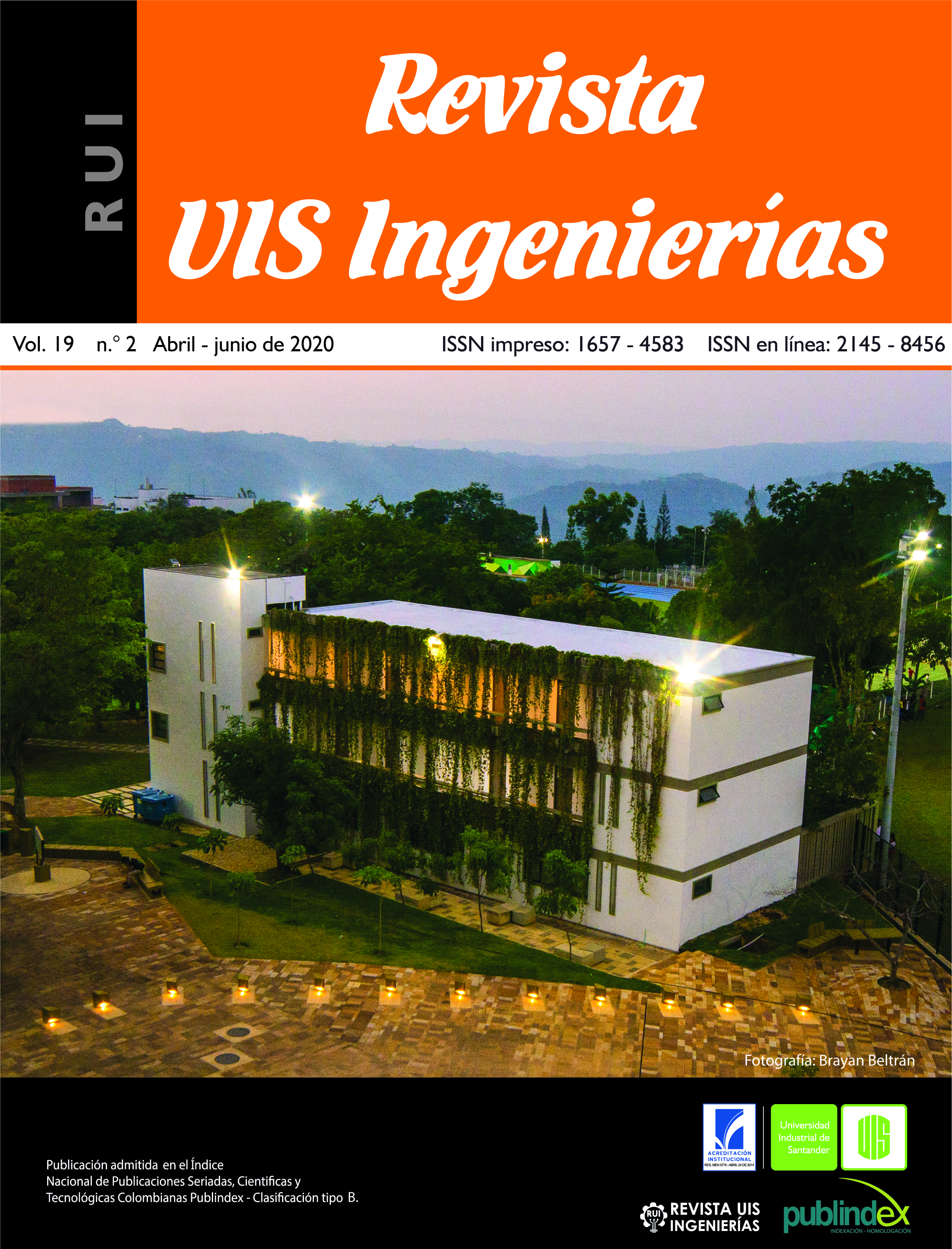Processing of brain signals from visual and auditory stimuli using wavelet analysis and artificial neural networks
Published 2020-03-24
Keywords
- EEG signal,
- entropy,
- evoked potential,
- multi-resolution analysis,
- artificial intelligence
How to Cite
Copyright (c) 2020 Revista UIS Ingenierías

This work is licensed under a Creative Commons Attribution-NoDerivatives 4.0 International License.
Abstract
This article presents the design and development of a portable prototype for the acquisition, processing and classification of EEG signals with the aim of characterizing visual and auditory stimuli. Two different patients were worked with to validate the results, and the signals were recorded for 4 seconds at a frequency of 500Hz. The patients were exposed to visual and auditory stimuli in different cases, whose frequency of appearance remained constant. For the recording of the signals, a 4-channel acquisition system was designed, which could be configured to work with unipolar or bipolar derivation, as required by the experiment. The selection of the best base in the multi-resolution wavelet analysis, two important parameters were taken into account, the measurement of entropy and the percentages of classification of these levels, because the evoked potentials are generally constant in their morphology, it was made coherent averaging giving as a result the space-time location where this evoked potential appears, Once the characteristics of the treated signal were obtained, they were classified using two different methods of artificial intelligence, neural networks and vector support machines. At this stage, the measurement of the standard deviation of the data was taken into account to ensure that the learning machine was trained correctly. The results obtained reliably demonstrate the general behaviour of the evoked potentials as a result of the stimuli presented. In addition, it was possible to verify the variation of the patient's alpha waves according to his or her state of relaxation or alert in each case, it is advisable to carry out a much more robust filtering system to increase the signal-to-noise ratio of the EEG signal, facilitate its analysis and improve the results.
Downloads
References
[2] J. F. D. Saa, J. R. Escorcia Gutiérrez, J. D. M. Rocha, “Diseño y Construcción de un Electroencefalógrafo de 32 Canales,” Partnering to Success Eng. Educ. Res. Dev., p. 8, 2008.
[3] L. H. Francisco, E. L. Johan, H. M. A. Leobardo, Z. I. Carlos, S. C. Susana, “Distribución de la densidad de corriente e impedancia de materiales alternativos en microelectrodos mediante el análisis de elemento finito,” en IFMBE Proceedings, 2013, vol. 33 IFMBE, pp. 975–978, doi: 10.1007/978-3-642-21198-0_248
[4] G. Borja, T. Ortega, A. Romero, “Design and Implementation of an equipment for the acquisition and visualization in pc of electroencephalographs,” Prospectiva, vol. 8, nº 1, pp. 21-28, 2010.
[5] R. Barea Navarro, “Instrumentación Biomédica,” tesis doctoral, Universidad de Alcalá, Madrid, España.
[6] A. Larrazábal, R. Acevedo, L. Rufiner, “Mejoramiento de la relación señal a ruido en potenciales evocados mediante métodos de regulación,” Revista Argentina de Bioingeniería, vol. 18, no. 1, pp. 9-14, 2012.
[7] A. E. Donoso, “Reducción de artefactos oculares en señales EEG: fieltrado adaptativo como alternativa a la regresión lineal,” [En línea]. Disponible en: https://hal.archives-ouvertes.fr/hal-00419918
[8] L. Alvares Escobar, “Análisis de Esquema de Filtrado para señales Electrocardiográfica (ECG),” proyecto de grado, Universidad Tecnológica de Pereira, Risaralda, 2007.
[9] B. A. Medina, R. Álvarez López, “Caracterización de Señales EEG mediante Wavelet Packet y Entropía Difusa para tareas de imaginación motora,” Ingeniería, vol. 22, no. 2, p. 226, May 2017, doi: 10.14483/udistrital.jour.reving.2017.2.a04
[10] K. J. Acuña Condori, “Procesamiento de señales electroencefalográficas en un sistema embebido para una interfaz cerebro máquina,” tesis posgrado, Pontificia Universidad Católica de Perú, 2017.
[11] J. Torre Abauita, “Procesado de señales EEG para una interfaz cerebro maquina (BCI),” tesis pregrado, Universidad Carlos III de Madrid, España, 2012.
[12] J. A. Cuartas, P. A. Madrigal, R. A. Torres, “Interfaz cerebro computador controlada por sincronización y desincronización relacionada a eventos en sujetos no entrenados,” in IFMBE Proceedings, 2013, vol. 33 IFMBE, pp. 611–614, doi: 10.1007/978-3-642-21198-0_156
[13] J. D. Asimbaya Molina, J. A. Suasnavas Tipan, “Diseño e implementación de un prototipo Brain Computer Interface(BCI), para la manipulación de una pinza robótica utilizando comunicación Bluetooth,” trabajo de grado, Universidad Politécnica Salesiana, Quito, Ecuador, 2014.
[14] S. Mourente Diaz, “Potenciales evocados auditivos de latencia media en el trastorno por déficit de atención e hiperactividad tipología y pronóstico de la respuesta al tratamiento,” tesis de doctorado, Universidad de Santiago de Compostela, España, 2008.
[15] L. Lorenzo López, “Psicología de atención visual y envejecimiento estudio mediante potenciales evocados,” Santiago de Compostela, España, 2007.
[16] L. Muñoz Peña, J. Corral, “Potenciales Evocados Cerebrales en el Contexto de la Investigación Psicología: una Actualización,” Anuario de Psicología, vol. 35, nº 1, pp. 3–21, 2004.
[17] A. Moran García, “Diseño de Interfaces Cerebro-Máquina Controlados Mediante Registros de EEG,” tesis pregrado, Universidad Autónoma de Madrid, España, 2015.
[18] L. F. Nicolas-Alonso, J. Gomez-Gil, “The National Center for Biotechnology Information,” 2012. [En línea]. Disponible: http://wwww.ncbi.nlm.nih.gov/pmc/articles/PCM33044110/
[19] R. Acevedo, “Técnicas para Detección y Estimación Eficiente de Potenciales Evocados,” CDyTS, vol. 8, no. 8, 2018.
[20] N. Debasish, M. J. Singh, S. Sahoo, J. Hazarika, “Wavelet Based De-noising of EEG Signal Acquired from Tele-serial Addicted Persons,” en 3rd International Conference on Recent Developments in Control, Automation & Power Engineering (RDCAPE) de 2019, pp. 265-269, doi: 10.1109/rdcape47089.2019.8979060

